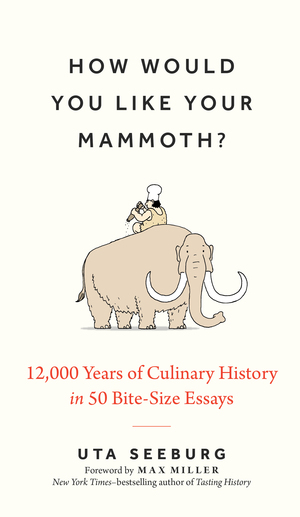 Enlarge Cover
Media/Desk Copy Request
Enlarge Cover
Media/Desk Copy Request
A culinary romp through 50 dishes that define human history—from prehistoric roasted mammoth to space-age dehydrated soup “[Uta Seeburg] brings the characters of history to life in fifty snackable essays . . . the amuse-boucheto a historical smorgasbord.”—Max Miller, New York Times–bestselling author of Tasting History
Did you know that ancient Egyptians mummified beef ribs for their dearly departed to enjoy in the afterlife? That Roman gladiators were relegated to a vegan diet of grains and beans? That the fast-food hamburger was a result of a postwar, high-efficiency work ethic?
This snackable collection of essays is a chronological journey through the culinary history of humankind, packed to the brim with juicy tidbits. With author Uta Seeburg as your guide, you’ll learn how certain dishes serve as windows into broader historical trends and the cultural values of the people who first invented them. As you read, you’ll discover why:
- Nomads in ancient Syria were deadly serious about hospitality
- A 16th-century cookbook author argued that beavers should be considered fish
- Roasted swan was the centerpiece of choice in 1650s high society—despite tasting awful
- A Portuguese princess was responsible for popularizing tea in England
- A king had to order his subjects to eat potatoes
. . . and much more. Foodies and history buffs alike will savor every amusing yet educational historical snapshot, from how a bureaucratic society fixated on record-keeping brought us one of the oldest recorded recipes (lamb stew with barley and onions) to how modern-day chefs are turning invasive species into haute cuisine. How Would You Like Your Mammoth? is a fascinating look at how the food we eat defines us—and always has.
“[Uta Seeburg] brings the characters of history to life in fifty snackable essays . . . the amuse-boucheto a historical smorgasbord.”—Max Miller, New York Times–bestselling author of Tasting History
“Pithy and enchanting, [How Would You Like Your Mammoth? is] an ideal introduction to broader historical topics. . . . Accessible, lighthearted essays display a knack for finding curious similarities across eras and cultures. . . . A culinary history celebrating human ingenuity.”—Foreword
“Reassuring readers that history isn't dull, colorless, or boring, Seeburg unquestionably captures our attention with these brief essays.”—Booklist
“Serves up a culinary tour through history, beginning back when the ‘unremarkable moochers’ known as Homo sapiens fed on scraps left behind by hyenas and saber-tooth tigers.”—The Wall Street Journal
“A concise masterclass—in these deft and era-spanning essays, Uta Seeburg compresses a vast culinary history into a collection that’s equal parts lively and illuminating.”—Mayukh Sen, author of Taste Makers
Uta Seeburg’s book [is] full of anecdotes and insights.”—Christoph Amend, Zeit magazine
Entertaining and surprising.”—Sanja Niemann, Brigitte
[Uta Seeburg’s] 50 stories are as amusing as they are instructive.”—Sybille Peine, Berliner Morgenpost
[A] very informative and amusing book.”—Daniela Zinser, Welt am Sonntag
[An] instructive and entertaining foray through culinary world history.”—Georg Renöckl, ORF Ö1
[A] fabulous little book.”—Nina Kobelt, Tagesanzeiger
Why didn’t anyone think of that before? […] How to Eat a Mammoth is a very entertaining book that proves that food reveals an incredible amount about people.”—Alexandra von Braunschweig, Ruhr Nachrichten
This is where world politics, curiosity, culinary delight, and uniformity meet.”—Felix Stenert, EKZ
With her 50 stories full of concentrated knowledge and curiosities, Uta Seeburg provides a bite-sized feast for the palate interested in cultural history. A literary treat that makes you want more!”—Julian Hienstorfer, Literatur-Couch.de


